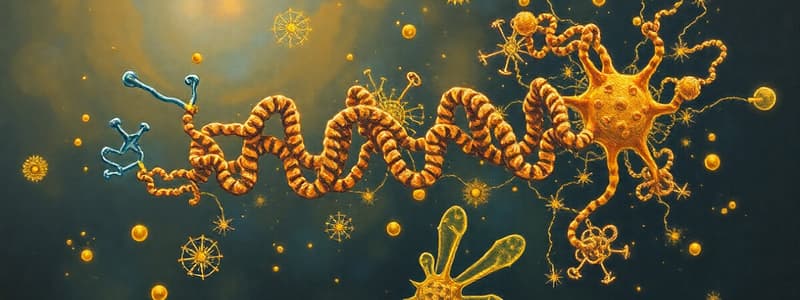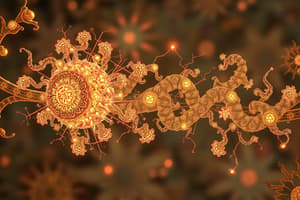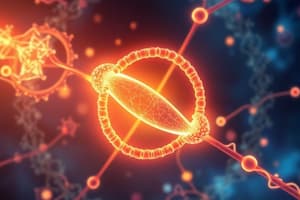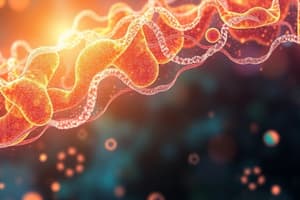Podcast
Questions and Answers
What is released during the hydrolysis of ATP?
What is released during the hydrolysis of ATP?
- Adenosine triphosphate
- Energy stored in phosphate bonds
- Chemical potential energy
- Adenosine diphosphate and inorganic phosphate (correct)
Which process describes the use of ATP to drive an endergonic reaction?
Which process describes the use of ATP to drive an endergonic reaction?
- Energy regulation
- Energy coupling (correct)
- Metabolic conversion
- Cellular respiration
Which type of work can ATP perform through energy coupling?
Which type of work can ATP perform through energy coupling?
- Electrical
- Gravitational
- Mechanical (correct)
- Thermal
What is the function of ATP in biological systems?
What is the function of ATP in biological systems?
What happens during ATP synthesis?
What happens during ATP synthesis?
Which process involves the storage of energy during metabolism?
Which process involves the storage of energy during metabolism?
What role do enzymes play in metabolic reactions?
What role do enzymes play in metabolic reactions?
What type of feedback mechanism involves the regulation of enzyme activity to inhibit a pathway?
What type of feedback mechanism involves the regulation of enzyme activity to inhibit a pathway?
Which statement accurately describes exergonic reactions?
Which statement accurately describes exergonic reactions?
What is the main source of energy that drives metabolism on Earth?
What is the main source of energy that drives metabolism on Earth?
What is the primary outcome of ATP hydrolysis?
What is the primary outcome of ATP hydrolysis?
Which process is considered exergonic?
Which process is considered exergonic?
What are the reactants in the process of cellular respiration?
What are the reactants in the process of cellular respiration?
During photosynthesis, which of the following is produced?
During photosynthesis, which of the following is produced?
Where does aerobic respiration take place within the cell?
Where does aerobic respiration take place within the cell?
What is required for the regeneration of ATP from ADP and Pi?
What is required for the regeneration of ATP from ADP and Pi?
Which statement accurately describes catabolic pathways?
Which statement accurately describes catabolic pathways?
In the context of photosynthesis, what is the role of light?
In the context of photosynthesis, what is the role of light?
What does ΔG = 0 indicate in a closed system?
What does ΔG = 0 indicate in a closed system?
What characterizes metabolic pathways in open systems like human cells?
What characterizes metabolic pathways in open systems like human cells?
What is the primary function of ATP?
What is the primary function of ATP?
Why is ATP considered unstable despite being energy-rich?
Why is ATP considered unstable despite being energy-rich?
Which of the following accurately describes the structure of ATP?
Which of the following accurately describes the structure of ATP?
In terms of energy transfer, what role does ATP play in cells?
In terms of energy transfer, what role does ATP play in cells?
What does it mean for a cell to be an open system?
What does it mean for a cell to be an open system?
Why does the metabolism in human cells not reach equilibrium?
Why does the metabolism in human cells not reach equilibrium?
What is the primary purpose of regulating metabolic pathways in a cell?
What is the primary purpose of regulating metabolic pathways in a cell?
Which of the following methods contributes to the regulation of enzyme activity?
Which of the following methods contributes to the regulation of enzyme activity?
Which statement best describes feedback inhibition?
Which statement best describes feedback inhibition?
How does regulation of gene expression affect enzyme production?
How does regulation of gene expression affect enzyme production?
Which enzyme in the tryptophan biosynthesis pathway is NOT directly mentioned in the regulation of enzyme production?
Which enzyme in the tryptophan biosynthesis pathway is NOT directly mentioned in the regulation of enzyme production?
Which gene is primarily responsible for the regulation of Enzyme 1 in the tryptophan biosynthesis pathway?
Which gene is primarily responsible for the regulation of Enzyme 1 in the tryptophan biosynthesis pathway?
What characterizes allosteric regulation of enzyme activity?
What characterizes allosteric regulation of enzyme activity?
Why must enzyme activity be regulated in metabolic pathways?
Why must enzyme activity be regulated in metabolic pathways?
What defines allosteric regulation in enzymes?
What defines allosteric regulation in enzymes?
Where do regulatory molecules typically bind in allosteric regulation?
Where do regulatory molecules typically bind in allosteric regulation?
Which of the following statements is true regarding allosteric inhibitors?
Which of the following statements is true regarding allosteric inhibitors?
What distinguishes heterotropic regulation from homotropic regulation?
What distinguishes heterotropic regulation from homotropic regulation?
What is an effect of an allosteric activator on an enzyme?
What is an effect of an allosteric activator on an enzyme?
What is common to both heterotropic and homotropic allosteric regulation?
What is common to both heterotropic and homotropic allosteric regulation?
Which statement about the regulation of enzymes is incorrect?
Which statement about the regulation of enzymes is incorrect?
How do allosteric enzymes typically behave when regulatory molecules bind?
How do allosteric enzymes typically behave when regulatory molecules bind?
Flashcards
Metabolism
Metabolism
The sum of all chemical reactions that occur within a living organism.
Anabolic processes
Anabolic processes
Metabolic reactions that build complex molecules from simpler ones, requiring energy input.
Catabolic processes
Catabolic processes
Metabolic reactions that break down complex molecules into simpler ones, releasing energy.
Bioenergetics
Bioenergetics
Signup and view all the flashcards
Internal energy
Internal energy
Signup and view all the flashcards
ATP Hydrolysis
ATP Hydrolysis
Signup and view all the flashcards
ATP Synthesis
ATP Synthesis
Signup and view all the flashcards
Energy Coupling
Energy Coupling
Signup and view all the flashcards
Endergonic Cellular Work
Endergonic Cellular Work
Signup and view all the flashcards
ATP-mediated Energy Coupling
ATP-mediated Energy Coupling
Signup and view all the flashcards
Equilibrium
Equilibrium
Signup and view all the flashcards
Open system
Open system
Signup and view all the flashcards
Metabolic pathway
Metabolic pathway
Signup and view all the flashcards
ATP (adenosine triphosphate)
ATP (adenosine triphosphate)
Signup and view all the flashcards
Energy rich bonds of ATP
Energy rich bonds of ATP
Signup and view all the flashcards
Unstable nature of ATP
Unstable nature of ATP
Signup and view all the flashcards
ATP's function in cellular processes
ATP's function in cellular processes
Signup and view all the flashcards
Catabolic pathways
Catabolic pathways
Signup and view all the flashcards
Anabolic pathways
Anabolic pathways
Signup and view all the flashcards
ATP
ATP
Signup and view all the flashcards
Photosynthesis
Photosynthesis
Signup and view all the flashcards
Cellular respiration
Cellular respiration
Signup and view all the flashcards
Molecule and energy exchange
Molecule and energy exchange
Signup and view all the flashcards
What is allosteric regulation?
What is allosteric regulation?
Signup and view all the flashcards
What is an allosteric activator?
What is an allosteric activator?
Signup and view all the flashcards
What is an allosteric inhibitor?
What is an allosteric inhibitor?
Signup and view all the flashcards
What is homotropic allosteric regulation?
What is homotropic allosteric regulation?
Signup and view all the flashcards
What is heterotropic allosteric regulation?
What is heterotropic allosteric regulation?
Signup and view all the flashcards
What is a regulatory site?
What is a regulatory site?
Signup and view all the flashcards
How does allosteric regulation affect enzyme function?
How does allosteric regulation affect enzyme function?
Signup and view all the flashcards
How do allosteric molecules affect enzyme conformation?
How do allosteric molecules affect enzyme conformation?
Signup and view all the flashcards
Why is metabolic regulation important?
Why is metabolic regulation important?
Signup and view all the flashcards
How is enzyme activity regulated?
How is enzyme activity regulated?
Signup and view all the flashcards
How does gene expression regulate enzyme activity?
How does gene expression regulate enzyme activity?
Signup and view all the flashcards
What is feedback inhibition?
What is feedback inhibition?
Signup and view all the flashcards
How does feedback inhibition work?
How does feedback inhibition work?
Signup and view all the flashcards
How does allosteric regulation impact enzyme activity?
How does allosteric regulation impact enzyme activity?
Signup and view all the flashcards
How are these two methods of enzyme regulation related?
How are these two methods of enzyme regulation related?
Signup and view all the flashcards
Study Notes
Introduction to Metabolism
- Metabolism encompasses all chemical reactions in an organism enabling energy storage (anabolic) and release (catabolic).
- Living organisms need energy to survive, sourced primarily from sunlight used in photosynthesis by plants.
- Cells behave as miniature factories, converting energy in various ways, exemplified by bioluminescence.
- Energy flows through the environment from the sun to producers (plants), then consumers (animals), and finally decomposers (fungi and bacteria).
Energy of Life
- All living organisms require energy to survive.
- Sunlight is the fundamental energy source.
- Plants utilize sunlight for photosynthesis to synthesize sugars.
- Energy is transferred through metabolic processes.
- The cell is a miniature factory where many reactions convert energy, such as in bioluminescence.
Metabolic Pathways
- Metabolic pathways are series of chemical reactions starting with a specific molecule and ending with a product.
- Each step is catalyzed by a specific enzyme.
- Pathways are controlled according to cellular needs.
Catabolic Pathways
- Catabolic pathways break down complex molecules into simpler ones.
- This process releases energy, demonstrated by cellular respiration.
- Cellular respiration converts glucose and oxygen into carbon dioxide, water, and energy in the form of ATP.
Anabolic Pathways
- Anabolic pathways build complex molecules from simpler ones.
- This process requires energy input.
- Examples include photosynthesis and protein synthesis from amino acids.
- Photosynthesis uses carbon dioxide, water, and light energy to produce glucose and oxygen.
Forms of Energy
- Energy is the capacity to cause change.
- Energy exists in various forms (kinetic and potential).
- Kinetic energy is associated with motion (e.g., thermal energy).
- Potential energy is stored energy due to the location or structure of matter (e.g., chemical energy).
- Thermodynamics is the study of energy conversion.
The Laws of Thermodynamics
- The first law states that energy can be transformed from one form to another but cannot be created or destroyed.
- The second law states that any spontaneous change in isolation increases the entropy, or disorder, of the universe.
Biological Order and Disorder
- Living organisms increase the entropy of the universe by releasing energy through metabolic processes.
- They maintain order by consuming energy to counteract the tendency for increasing disorder.
Free Energy and Metabolism
- Organisms live by consuming free energy, a type of energy capable of doing work under cellular conditions in a closed system.
- The free energy change (ΔG) of a reaction indicates whether the reaction is spontaneous (ΔG<0) or not (ΔG>0).
Exergonic and Endergonic Reactions
- Exergonic reactions release energy and are spontaneous (ΔG<0).
- Endergonic reactions absorb energy and are not spontaneous (ΔG>0).
Equilibrium and Metabolism
- Reactions in a closed system eventually reach equilibrium (ΔG=0).
- Living cells (open systems) constantly exchange materials, preventing equilibrium and maintaining a constant flow of energy.
The Structure of ATP
- ATP (adenosine triphosphate) is the cell's energy shuttle.
- It stores energy in phosphate bonds.
- ATP provides energy for cellular functions, stemming from its instability and inherent energy content.
ATP Hydrolysis and Regeneration
- ATP hydrolysis releases energy by breaking a phosphate bond, in the process converting ATP to ADP.
- Conversely ATP synthesis stores energy through the formation of phosphate bonds.
- ATP hydrolysis to ADP releases energy, used to drive cellular work.
Energy Coupling by ATP
- ATP powers cellular work by energy coupling, using an exergonic process to drive an endergonic process.
- Main types of endergonic cellular work include mechanical, transport, and chemical processes.
ATP Hydrolysis
- Exergonic reaction that releases energy from ATP by break down of terminal phosphate bonds
Enzymes
- Enzymes are catalytic proteins that speed up metabolic reactions by lowering activation energy barriers.
- Enzymes are not consumed during the reaction.
- They increase rate (but not spontaneity) of reactions.
The Activation Barrier
- Chemical reactions involve bonds breaking and forming.
- Activation energy (Ea) is the initial energy input needed to start a reaction.
- To initiate a reaction, reactants are destabilized to react more easily.
- Heat supplies the initial energy input to increase molecular collisions and reaction rates.
The catalytic cycle of an enzyme
- Enzymes bind to substrates in the active site. Enzymes undergo conformational changes to induce a better fit; this is the induced fit process.
- Substrates are converted to products, then released from the active site, returning the enzyme to its initial state. This allows for another catalytic cycle.
Enzyme Specificity
- Enzymes only work on specific substrates.
- Enzyme shape determines its function.
- 3-D enzyme shape permits specific interactions with substrates.
The Active Site
- The active site is the region of the enzyme where the substrate binds.
- An enzyme's active site is typically a crevice or pocket that is specific to the shape of a given substrate.
- The induced-fit model describes how the enzyme's active site molds around the substrate. This better accommodates the substrate, increasing the efficiency and efficacy of the enzyme-catalyzed reaction process.
Enzyme activity regulation
- The regulation of enzyme activity is vital for maintaining cellular homeostasis.
- Enzyme activity can be controlled via several processes including covalent regulation, allosteric regulation, and feedback inhibition.
Regulation of Enzyme Activity
- Cells tightly regulate metabolic pathways by controlling enzyme activity.
Feedback Inhibition
- The end product of a metabolic pathway regulates its own synthesis by inhibiting an earlier step.
- This prevents the cell from overproducing unnecessary products.
- Feedback inhibition, through allosteric regulation, creates a feedback loop that modulates enzyme activity.
Allosteric Regulation of Enzymes
- Allosteric enzymes have multiple binding sites; one for the substrate as well as a regulatory site for a modulator.
- Binding of a regulatory molecule (activator or inhibitor) changes enzyme activity.
- Positive allosteric regulation activates the enzyme, increasing its activity.
- Negative allosteric regulation inhibits the enzyme, reducing its activity.
Allosteric Activators and Inhibitors
- Allosteric activators stabilize the active conformation of the enzyme.
- Allosteric inhibitors stabilize the inactive conformation.
- Regulatory sites are typically distinct from the active sites of the enzyme.
Homotropic Allosteric Regulation (Cooperativity)
- Homotropic activation occurs when a substrate molecule simultaneously acts as an activator and a substrate. An example of this is the binding of oxygen (substrate) to hemoglobin.
- Substrate binding to a subunit increases binding affinity for other subunits.
Specific Localization of Enzymes within the Cell
- Enzymes in the same pathway are often located close together in cells.
- Enzymes can be grouped into complexes, embedded within membranes, or housed within organelles.
- Mitochondria, for instance, are the sites of cellular respiration.
Enzyme Inhibitors (reversible vs irreversible)
- Irreversible inhibitors modify enzymes permanently.
- Examples of irreversible inhibitors include sarin, DDT and penicillin derivatives.
- Reversible inhibitors attach and detach to the enzyme. The inhibitor may either bind to the active site (competitive) or to allosteric sites (non-competitive).
Competitive vs Non-Competitive Inhibition
- Competitive inhibitors bind to the enzyme’s active site, preventing substrate from binding.
- Non-competitive inhibitors bind to a site other than the active site, which alters the enzyme's active site, preventing the reaction that would normally occur.
Effects of Local Conditions on Enzyme Activity
- Enzyme activity is affected by factors like pH and temperature.
- Each enzyme has an optimal pH and temperature range for maximal activity in a given setting.
Studying That Suits You
Use AI to generate personalized quizzes and flashcards to suit your learning preferences.




